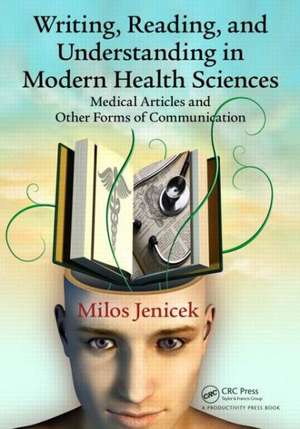Writing, Reading, and Understanding in Modern Health Sciences: Medical Articles and Other Forms of Communication
Autor Milos Jeniceken Limba Engleză Paperback – 12 mar 2014
Writing, Reading, and Understanding in Modern Health Sciences: Medical Articles and Other Forms of Communication will help the authors of medical articles communicate more effectively in today's practice and health research environment. It explores the most effective practices for communicating using three main medical literature formats: through scientific articles, articles where the subject is not based on the practice of the scientific method, and business reports.
Describing how to think beyond the prevailing IMRAD article format, this book focuses on the nature, content, domains of thought, and meanings of medical articles. The ideas and underlying propositions in this book are complementary to specific requirements appropriate for each type of medical journal. After reading this book you will better understand:
- How to write what is considered the most important type of medical article, the research-based medical article
- How to write an evidence-based argumentative medical article
- The challenges of clinical case reporting
- The general framework of medical and research ethics
- Classification of medical articles and their underlying studies from the causal standpoint
A must-read for all writers, readers, and users of medical articles, this book supplies the tools you need to write compelling medical reports that can help to improve the practice, research, and quality of healthcare at all levels.
Preț: 352.12 lei
Preț vechi: 454.14 lei
-22% Nou
Puncte Express: 528
Preț estimativ în valută:
67.38€ • 69.92$ • 56.32£
67.38€ • 69.92$ • 56.32£
Comandă specială
Livrare economică 24 februarie-10 martie
Doresc să fiu notificat când acest titlu va fi disponibil:
Se trimite...
Preluare comenzi: 021 569.72.76
Specificații
ISBN-13: 9781482226454
ISBN-10: 1482226456
Pagini: 232
Ilustrații: 18 black & white illustrations, 4 black & white tables
Dimensiuni: 178 x 254 x 18 mm
Greutate: 0.41 kg
Ediția:1
Editura: Taylor & Francis
Colecția CRC Press
Locul publicării:Oxford, United Kingdom
ISBN-10: 1482226456
Pagini: 232
Ilustrații: 18 black & white illustrations, 4 black & white tables
Dimensiuni: 178 x 254 x 18 mm
Greutate: 0.41 kg
Ediția:1
Editura: Taylor & Francis
Colecția CRC Press
Locul publicării:Oxford, United Kingdom
Public țintă
Professional Practice & DevelopmentCuprins
Essays as Communication Tools. Research-Based Medical Article: Writing What Is Considered the Most Important Type of Written Medical Article. Thesis: A Key Feature of the Medical Article Introduction—Seven Cornerstones for Reporting a Research-Based Study. Definitions: A Key Feature of the Material and Methods Section of a Medical Article. Reporting Research Critically and the Argumentative Way: A Key Feature of the Results and Discussion Sections of a Medical Article. Cause–Effect Relationships: A Key Feature of the Discussion and Conclusion Sections of a Medical Article. Challenges of Clinical Case Reporting: Casus Clinicus Revisitus and Redivivus. Medical Ethics and Publication Ethics. Summary: Future Ways of Knowledge Communication.
Descriere
This book explores the most effective practices for communicating using three main medical literature formats: scientific articles, articles where the subject is not based on the practice of the scientific method, and business reports. The book focuses on the nature, content, domains of thought, and meanings of medical articles. It includes details about essay-type articles, research-based articles, thesis as introduction sections, definitions as part of the material and methods sections, modern argumentation, and critical thinking. The ideas presented in this book are complementary to the specific requirements appropriate for each type of medical journal.
